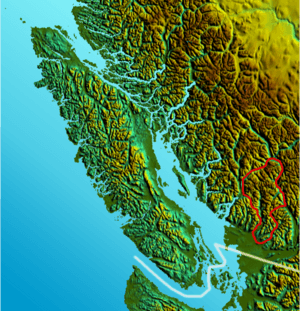Lillooet River facts for kids
Quick facts for kids Lillooet River |
|
|---|---|

Location map of the Lillooet River; Lillooet Lake not shown.
|
|
| Country | Canada |
| Province | British Columbia |
| Physical characteristics | |
| Main source | Silt Lake Coast Mountains 784 m (2,572 ft) 50°43′51″N 123°41′25″W / 50.73083°N 123.69028°W |
| River mouth | Harrison Lake 9 m (30 ft) 49°44′50″N 122°8′44″W / 49.74722°N 122.14556°W |
| Length | 209 km (130 mi) |
| Basin features | |
| Tributaries |
|
The Lillooet River is a major river in the southern Coast Mountains of British Columbia, Canada. It starts at Silt Lake, which is on the edge of the Lillooet Crown Icecap. This spot is about 80 kilometers (50 miles) northwest of Pemberton.
The upper part of the river's valley is about 95 kilometers (59 miles) long. It flows into Lillooet Lake about 15 kilometers (9 miles) downstream from Pemberton. This area is near the Mount Currie reserve, home to the Lil'wat branch of the St'at'imc people. The flat lands along the river, from Pemberton Meadows to Lillooet Lake, are known as the Pemberton Valley and are used for farming.
After flowing through the 30-kilometer (18.6-mile) long Lillooet Lake, the river continues its journey. It starts again just north of a place called Skookumchuck Hot Springs, which the St'at'imcets people call Skatin. The lower part of the Lillooet River, from Lillooet Lake to Harrison Lake, is about 55 kilometers (34 miles) long.
The main streams that flow into the Lillooet River are Meager Creek, the Ryan River, the Green River, and the Birkenhead River. Once the Lillooet River reaches Harrison Lake, it changes its name to the Harrison River. The Harrison River then flows into the mighty Fraser River near the First Nations community of Chehalis.
In the past, during the Fraser Canyon Gold Rush, the lower Lillooet River and Lillooet Lake were part of an important route. This route connected the coast to the interior of British Columbia. It was known as the Douglas Road.
River Name Changes
Did you know there was once another river called the Lillooet River? Until the 1910s, the name Lillooet River also referred to what is now known as the Alouette River. This river is located in Maple Ridge.
A neighborhood grew up on the south branch of this "other" Lillooet River. It became known as South Lillooet. However, to avoid confusion with the main Lillooet River, the local postmaster was asked to choose a new name. He picked Yennadon, named after his family's home in England. The river's name was officially changed to "Alouette" on March 31, 1915. The name "Alouette" was chosen because it sounded similar to "Lillooet."
How the River Was Dammed by a Volcano
The Lillooet River has a fascinating geological history! About 2,400 years ago, something amazing happened. A huge volcanic eruption from the Mount Meager massif caused the river to be blocked.
This eruption was a powerful type called a Plinian eruption. It sent out a lot of volcanic rock fragments, called breccia. These rocks formed a natural dam across the Lillooet River.
However, this breccia dam was not very strong. Over time, the river's powerful water began to wear away the volcanic rock. Eventually, the water broke through the dam. This created the beautiful Keyhole Falls that we see today.
When the water first broke through, it caused a massive flood. This flood was incredibly powerful! It was strong enough to carry away huge blocks of breccia, some as big as small houses.
See also
 In Spanish: Río Lillooet para niños
In Spanish: Río Lillooet para niños

